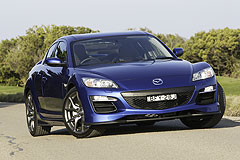Next Mazda MX-5 to twin with RX-9
BY BYRON MATHIOUDAKIS | 24th Mar 2009

While the classic front-engine and rear-wheel drive proportions will carry through, the fourth-generation roadster will introduce smaller and far more efficient engine choices, lighter running gear and even electric power steering, to make the MX-5 the greenest – as well as the most controversial – convertible in Mazda’s history.
A sub-1000kg kerb weight is the target, compared to the latest MX-5’s 1129kg to 1177kg mass.
Overseas reports suggest that the 2012 MX-5 is being developed alongside a secret new 2+2-seater coupe that will both replace and undercut the pricey RX-8 as Mazda’s flagship, and is deliberately being devised to evoke memories of the first RX-7 of 1978.
Also due in three years, ‘RX-9’ will be the closed coupe’s probable moniker, earning the right to be powered by a rotary engine.
But while both Mazda sports cars will share the same underbody architecture, the MX-5 will boast a far bolder visage in both soft-top and retractable hardtop configurations than any of the three previous generations since 1989.
Last year, Mazda design boss Laurens van den Acker told one European publication: “The last (MX-5) was too conservative and we can’t do another car like that. We need to make it more dramatic and give it some balls.” By contrast, the RX-9 will abandon the sedan-like four-seater bodystyle and ‘suicide doors’ of its RX-8 predecessor for a shorter and sleeker two-door shape boasting a classic coupe silhouette.

According to a Mazda insider, there is also “no way” the next MX-5 will adopt the RX-9’s rumoured ‘16X’ 200kW-plus 1.6-litre twin-chamber rotary engine that is said to be more than 20 per cent more economical and significantly less polluting than the existing RENESIS 1303cc rotary unit found in the RX-8, as it will push the price point well beyond the current roadster’s sub-$45,000 level.
Further, the inevitable size and mass increases associated with using a more powerful engine like a rotary, as well as the larger brake, clutch, suspension and body/chassis bracing componentry needed as a result of the associated output increases, are an anathema to Mazda’s weight-reduction goals.
Instead, the company is said to be developing a range of light and compact 1.4-litre and 1.6-litre direct-injection petrol engines that will use forced induction such as a turbocharger to achieve performance levels equal to or better than the 1.8 and 2.0-litre four-cylinder units offered today.
Fuel consumption and emissions outputs that are a fraction of today’s MX-5 are central to the small engine cause.
They are also behind the dropping of the lauded hydraulic powered rack and pinion steering system, for an electric unit.
Our source is also pessimistic about the MX-5’s chances of gaining Mazda’s upcoming dual-clutch manual gearbox that is slated for the RX-9, on the grounds of both price and complexity.
Meanwhile, while today’s MX-5 and RX-8 share suspension modules, Mazda’s concerted push to regain the lightness and litheness of the first-generation NA MX-5 model means the bulky double wishbone front end is expected to give way to a lighter set-up on both models.
Whether the next MX-5 and RX-9 adopt similarly sophisticated front wishbones and rear multi-link arrangements remains to be seen.
However, it is likely that the front-midship drivetrain layout that sees the current MX-5’s engine located just behind the front axle will again be used, to help it and the RX-9 achieve the desired 50/50 front-to-rear weight distribution.
GoAuto has learned that, when development of the existing NC-series MX-5 commenced in 2002, Mazda was constrained by its previous overlords Ford to keep costs down by using the heavy RX-8 hardware, and this created many headaches for the engineers.
“This mistake will not be repeated,” our source promised.
Incredibly, considering the strong following the MX-5 has had over the past 20 years, the NC soft-top almost never made it to production for the same reason, as Ford was keen to replicate the success of the Peugeot 206 CC with a retractable folding hard-top design.
Mazda’s engineers in Japan, in strong favour of continuing with the light fabric roof, devised two NC MX-5 prototypes, but the soft-top was initially knocked back because it required different – and prohibitively expensive – rear-quarter sheetmetal to the signed-off folding hardtop model.
“But once Ford design boss J. Mays saw how good the soft-top MX-5 looked against the retractable hard-top version, he convinced Ford’s hierarchy to invest in both roof options,” our source revealed.
Read more:
First drive: Revisionist roadster from MazdaMazda’s upbeat sales forecasts